5 min to read
Phone calls? Aren't they a thing of the past? Everyone uses the internet nowadays. Well, phone calls are not completely obsolete. When you look back to the past (when internet connection was insufficient or non-existent) people used calls to get, or to stay in touch. But, just because the internet has improved so much over the last few years and made itself indispensable in our everyday life, it doesn’t mean that phone calls have become a thing of the past or are down right obsolete. In fact, Google’s research shows that 70% of mobile searchers use the click to call feature.
Furthermore, 47% of mobile searchers say that if a business doesn't have a phone number associated with their search results, they will be more likely to explore other brands. After all, phone calls are a one-to-one form of communication. They are much more personal and direct, and contain verbal indicators that just aren't available when using a website or Google alone. So it's clear that phone calls are an incredibly important channel for businesses, and with effective marketing, you can increase the number of phone calls from your website. The next logical step then is to collect the information about the clicks received and start drawing insights from that. You can do this with Google Tag Manager.
IMPORTANT INFORMATIONIncorrect changes in your GTM might compromise all your current traffic information. If you are not an expert don't do it. |
Google Tag Manager for Tracking Phone Call Clicks
If you have GTM installed on your website, you can implement phone click tracking without having to resort to developers and changing your website code. Before we get down to business, here’s what you’ll need to successfully track your phone clicks using Google Tag Manager:
- Google Tag Manager account
- Google Analytics account
- A website with a click-to-call phone number
The following instructions will be most helpful if you have GTM installed in your website and are familiar with the basic concepts like previewing and publishing a container, creating tags and triggers and enabling built-in variables.
#1 Choose and enable the information you want to report on
To be able to send information to Google Analytics (GA) we need to be able to pick it up from the website. Most commonly, we want to track when the click happens, and if you have your phone number on more than one page, where it happens. To successfully track phone clicks you need to enable built-in variables in GTM. You will only need to enable Clicks and Pages Variables.
![]()
NOTE: Depending on your website and the solution implemented, you might not need all the variables in these categories. If you're not sure, start by enabling all the variables- you can always go back and disable the ones you don't need.
#2 Create the Trigger

- Name your Trigger and choose the type Just Links
- Check Wait for Tags and Validation
- Enable the trigger on the website pages where there is a phone number
- Configure the trigger to fire on Some Link Clicks and when Click URL contains tel:
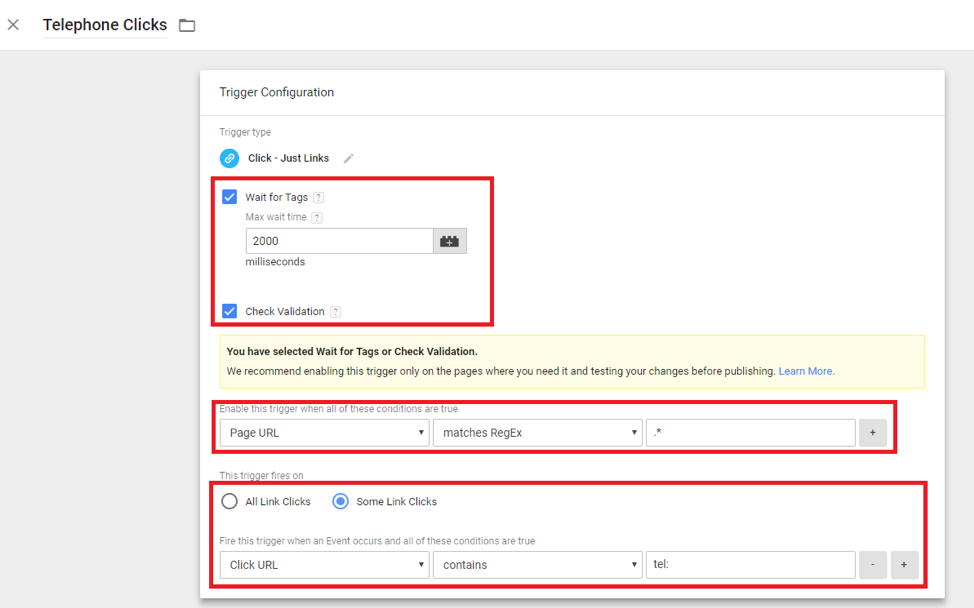
NOTE: Codedesign’s phone number is on every page of our website, so we don’t really want to limit the pages where this trigger will fire. For this we use Page URL matches, RegEx.*Adjust accordingly to your situation.
#3 Create the Tag
Create a new tag using your adopted nomenclature and choose the type of GA you’re using. (We have upgraded to Universal Analytics, but if you are still using the classic Analytics platform, there’s an option further below on the list).
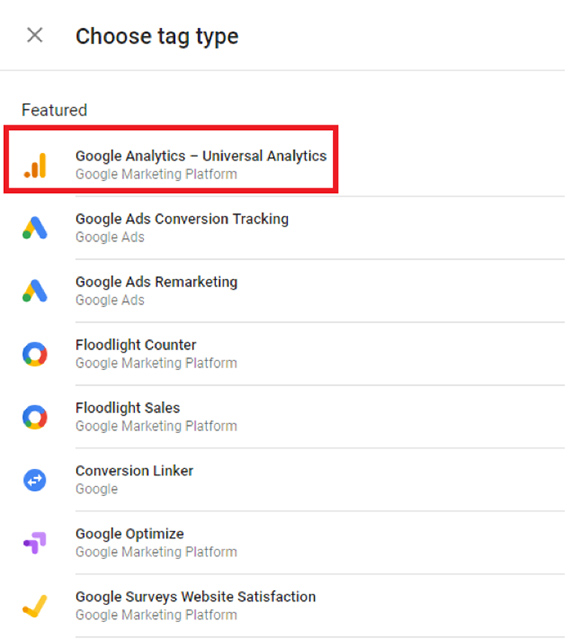
- Choose Track Type Event.
- Fill Category, Action, and Label as you want them to appear in GA.
- Optionally, fill Value as you want it to appear on GA. We’ll leave it blank.
- Choose the analytics property where you want to receive this event in Google Analytics Settings.
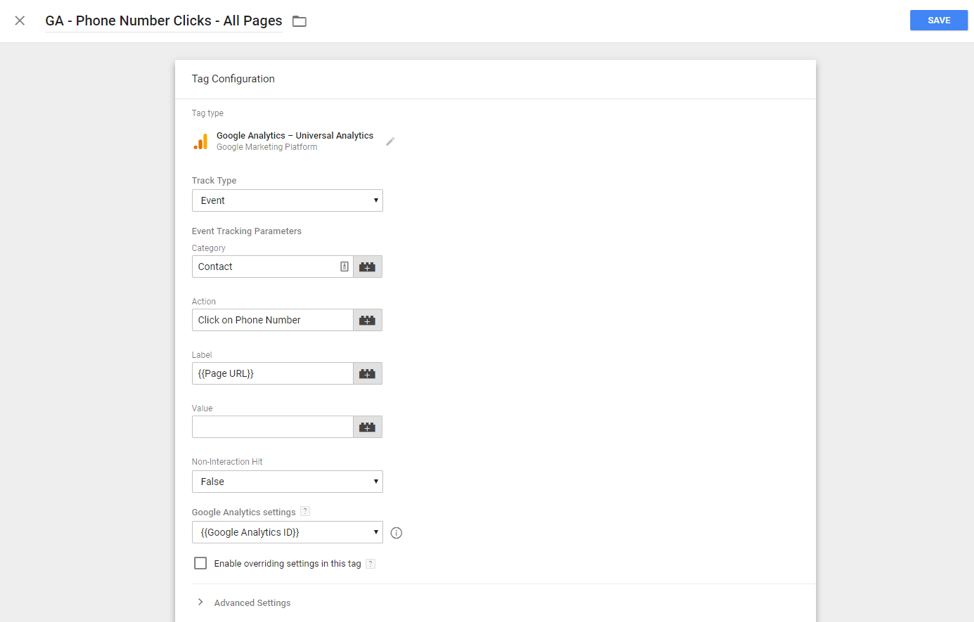
NOTE: In this case, we want to track where the phone number was clicked since it’s available on every page, so our Label is Page URL. If you have more than one phone number on your website and on a specific page, you might consider using Click URL to send the number that was clicked instead of the page where it was clicked. Additionally, if you want to track both, you can use the Action field for Click URL and the rest as it’s presented above. Select the trigger you just created in Triggering and Save your Tag.

In the end, you should have something like below:
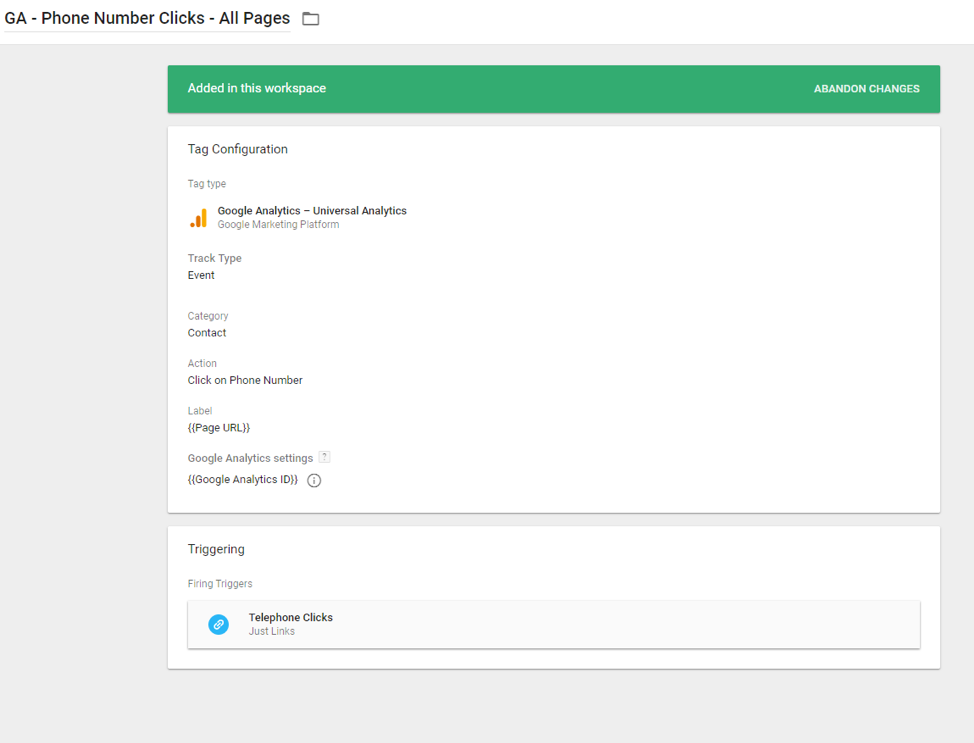
#4 Test and Debug
Now, enter Preview mode in GTM and open your website.  Then, click the phone number you want to track and check if the tag fired properly.
Then, click the phone number you want to track and check if the tag fired properly. ![]()
Don't forget to check on the Google Analytics Real-Time report if the event is configured as you want.

If you’re happy with the setup, you can publish your container.
NOTE: In the Real-Time report, you won’t be able to see the Label you set up in GTM. To be able to view the label, you will have to wait for the next day when the data is loaded into GA. This data can be found in the Behavior report, under Events. Filter for the Category you created. In our case, filter to Click on Phone Number and Select Label to see the URL's where the phone number was clicked.
![]()
#5 Set up Analytics
The Events report might give you some insights about your telephone clicks, but when you want to combine this information with Acquisition, you can only do it with Category, Action or Label individually. This may become quite hard to read if you have a high number of events set up. One way to cross this information is to create a goal that will invariably be available in Acquisition and other sections in a more readable way. To do this, go to your goals list and click + NEW GOAL
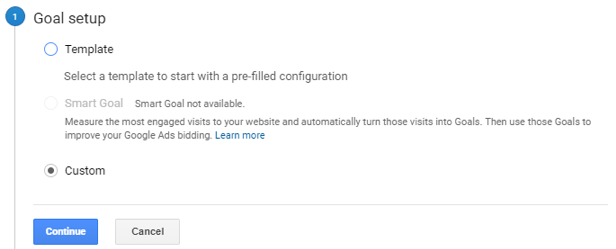
Set it as Custom. Click Continue. Be sure to give your goal a name that will identify it among the others and select Event. Click Continue.
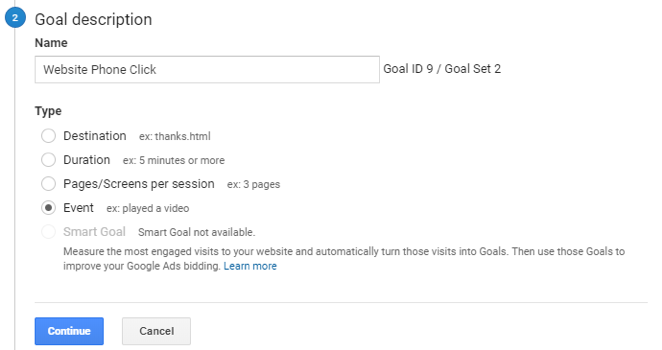
Fill the Event’s Category and Action exactly as you did on GTM. Click Save.
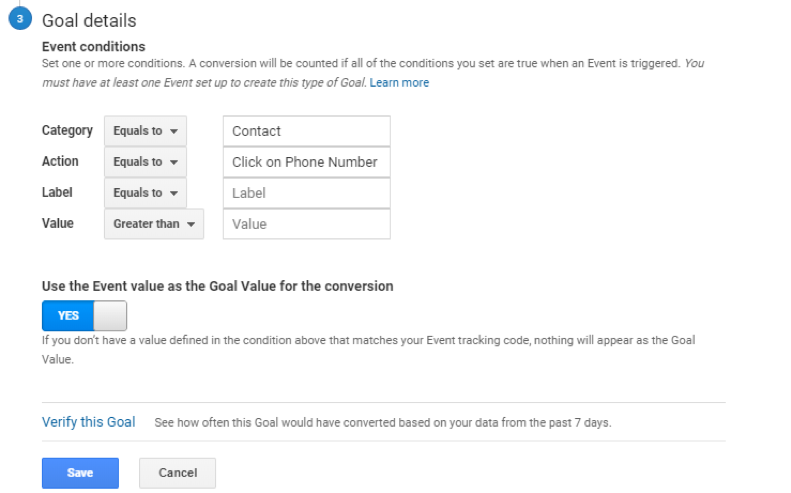
NOTE: If you are dynamically receiving the Label field as we set up previously, leave it blank. If you populated it with a constant value in GTM add it here as well. After you set up your Goal, you can see the channels, sources, etc. that converted the most:
![]()
Final Thoughts
The click to call feature is indispensable nowadays with a major part of online users using mobile devices to browse and call. It is also important that you set up phone call tracking so you can track where the users are coming from and what content on your website inspired them to get in touch with your business. Being able to do this with GTM has made this tracking easy and fast to implement. If you need further assistance tracking your phone call clicks with GTM, don't hesitate to give us a call!
IMPORTANT INFORMATIONIncorrect changes in your GTM might compromise all your current traffic information. If you are not an expert don't do it. |
About the Expert

This week's Voice of Experts article was written by Inês Garrinhas. Inês is a Web Analytics & GTM Specialist at Codedesign. When she's not tracking phone call clicks or building custom data studio reports for our clients, you can find her catching Pokémon and dragging her friends to Karaoke.
You can connect with Inês on LinkedIn, here.



4 comments
Add comment ×
Very nice article. Very explicative and useful... (I hope... hehe, still to implement). Just a question, please.. If I have MORE than a phone number in my page... Do I have to create a Tag for each one of them? Thanks.
Thanks, that was really helpful. Can you clarify at all which fielfds exactly in Tag Manager correlate to the Event Category and Action in Analytics?
I just used this article for tracking my calls clicks and wanted to thank you.
Really very informative blog for novice.